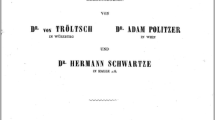Abstract
The letter to the editor plays a dual role in the literature. It serves a corrective critical function but also has the capacity to spread and share knowledge. We sought to identify the role and theme of letters to the editor published in four leading otorhinolaryngology journals, to elicit how well this form of communication is being utilised. All letters to the editor published in; Clinical Otolaryngology, The Laryngoscope, The European Archives of Otorhinolarygnology and The Journal of Laryngology and Otology, for the year 2012, were examined and the individual journal guidelines for submission of letters were noted. Seventeen different countries produced a total of 92 letters for the year 2012. The majority of letters originated from Otolaryngology/Head and Neck departments (78 %). Clinical Otolaryngology contributed to 58 % of total letters, of which 55 % were unrelated to original journal material (n = 29). The Laryngoscope published letters solely in response to original journal material. The Journal of Laryngology and Otology was the only journal to index letters with their corresponding article. More letters agreeing (49 %) than disagreeing (32 %) were published, with the remaining letters either clarifying or ignoring issues raised. Letters to the editor serve two main purposes; post-publication peer review and sharing experiences with fellow readers. Both are equally important in maintaining journals’ high standards. Indexing needs to be improved otherwise valuable comment does not endure while the original manuscript’s message lives on.
Similar content being viewed by others
References
Peh WC, Ng KH (2010) Writing a letter to the Editor. Singapore Med J 51(7):532–535
Dotson B (2013) Writing a letter to the editor. Am J Health Sys Pharm AJHP Off J Am Soc Health Syst Pharm 70(2):96–97
Winker MA, Fontanarosa PB (1999) Letters: a forum for scientific discourse. JAMA J Am Med Assoc 281(16):1543
Spodick DH (1996) Evidence-based medicine. Letters pages are essential for peer review. BMJ (Clin Res ed) 312(7046):1611
Morgan PP (1985) How to write a letter to the editor that the editor will want to publish. Can Med Assoc J 132(12):1344
Papanas N, Georgiadis GS, Maltezos E, Lazarides MK (2009) Letters to the editor: definitely not children of a lesser god. Int Angiol J Int Union Angiol 28(5):418–420
Afifi M (2006) Reviewing the “Letter-to-editor” section in the bulletin of the World Health Organization, 2000-2004. Bull World Health Organ (BLT) 10
Leong SC (2006) Publish or perish. Clin Otolaryngol Off J ENT-UK Off J Netherlands Soc Oto Rhino Laryngol Cervico Facial Surg 31(4):350–352
Fenton JE, Khoo SG, Ahmed I, Ullah I, Shaikh M (2004) Tackling the case report. Auris Nasus Larynx 31(3):205–207 (discussion 7)
Bhopal RS, Tonks A (1994) The role of letters in reviewing research. BMJ (Clin Res ed) 308(6944):1582–1583
Neghina R, Neghina AM (2011) How to build a scientific publishing career based on hundreds of letters-to-the-editor: “The Art of Loss”. Account Res 18(4):247–249
Horton R (2002) Postpublication criticism and the shaping of clinical knowledge. JAMA J Am Med Assoc 287(21):2843–2847
Spodick DH (1981) The peer review system and the editor’s correspondence. Arch Intern Med 141(9):1121
Conflict of interest
None.
Author information
Authors and Affiliations
Corresponding author
Rights and permissions
About this article
Cite this article
Tierney, E., O’Rourke, C. & Fenton, J.E. What is the role of ‘the letter to the editor’?. Eur Arch Otorhinolaryngol 272, 2089–2093 (2015). https://doi.org/10.1007/s00405-014-3289-7
Received:
Accepted:
Published:
Issue Date:
DOI: https://doi.org/10.1007/s00405-014-3289-7




